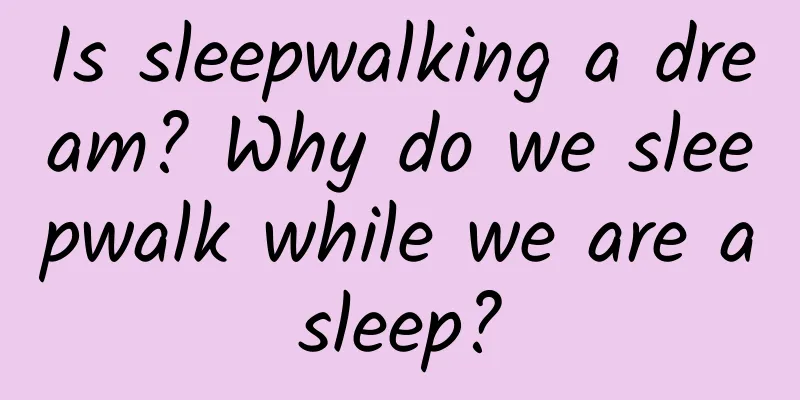Is sleepwalking a dream? Why do we sleepwalk while we are asleep?

|
When it comes to sleepwalking, you might think of this image: a person who was sleeping soundly suddenly gets up and goes out, walks around the house unconsciously, and finally goes back to bed quietly. He doesn't respond when you call him. Why does this person suddenly sleepwalk in the middle of the night? Does the sleepwalker know what he is doing? This starts with the human sleep cycle. In the 1950s, Eugene Aserinsky and Nathaniel Kleitman, scholars at the University of Chicago, had volunteers fall asleep and then scanned their brains with an MRI. They found that brain waves changed periodically throughout the sleep process. Specifically, sleep is divided into two states: rapid eye movement (REM) and non-rapid eye movement (NREM). These two states alternate in a cycle of about 90 minutes throughout sleep. REM is what we often call "light sleep". Although you fall asleep and most of your muscles relax during this stage, your brain is still very active and your brain electrical activity is very similar to that of a waking state. Dreams usually occur during this stage. NREM (read letters directly) is divided into three stages: N1, N2, and N3. N3 is the deepest sleep and the most relaxed stage. Coincidentally, sleepwalking mostly occurs in this stage. Under normal circumstances, most areas of the brain have rested in this stage. But sleepwalkers are different. In 2000, a study published in The Lancet showed that during sleepwalking, the brain is in a "split" state, with areas related to consciousness and cognition still resting, while areas related to behavior and movement are activated. Different areas "act independently", so people get up unconsciously, wander around the house aimlessly, and are difficult to wake up. But scientists are still studying what exactly causes this condition. The most critical cause of sleepwalking may be heredity and genes. A 1980 survey found that if one parent had sleepwalking experience, 45% of children would have sleepwalking symptoms; if both parents had sleepwalking, the probability of sleepwalking in children was even greater. In 2011, researchers from the Washington University School of Medicine in St. Louis published a paper on sleepwalking and genetics in the medical journal Neurology. The researchers analyzed the genes of members of a "sleepwalking family" in which four generations had sleepwalking symptoms. The results showed that there was a defect on their chromosome 20. The researchers speculated that it might be this small defect that caused all four generations to suffer from sleepwalking problems. However, it is still unknown which genes cause sleepwalking. We hope that future advances in genetics will reveal the answer to this mysterious phenomenon. This article is a work supported by Science Popularization China Starry Sky Project Team Name: The Nutcracker Review: Tao Ning Produced by: China Association for Science and Technology Department of Science Popularization Producer: China Science and Technology Press Co., Ltd., Beijing Zhongke Xinghe Culture Media Co., Ltd. |
<<: Numb hands and headache? It's not because of lack of rest! It's probably a stroke!
>>: Future planetary gas station - space station "T" configuration
Recommend
After reading 20,000 Weibo posts, let’s take a look at Durex’s marketing tactics
From the first well-known "Legend of the Sho...
Who stole your users?
When we are doing product or brand marketing , it...
Some ingenious tricks for iOS development 2
Some ingenious tricks for iOS development 2 Is it...
How to achieve super high conversion rate with creative home appliance materials?
The performance marketing track has welcomed more...
ID photo PS retouching tutorial "The most beautiful ID photo retouching" video tutorial
Training course video content introduction: By ma...
How much does the handwritten notes of the top student of Hengshui key middle school cost?
The reason why Hebei Province exists is because o...
Mustard VS pepper, why is the spiciness of mustard more addictive?
This article was reviewed by Dr. Tao Ning, Associ...
Baidu has come up with a new trick for promotion, it needs to be strictly investigated!
Faced with the increasing intensity of Internet s...
Why does it only take 2 minutes to withdraw a WeChat message?
The ancients said, "Once words are spoken, t...
How can new marketers quickly understand the characteristics of online marketing channels?
We have compiled 16 mainstream online promotion c...
Promotion on Bilibili: 8 tips to become popular!
Today we will take a look at the mechanism of Bil...
Why hasn't the smallpox virus been eradicated?
Recently, the Global Times reported that frozen b...
How much is the price of the automatic printing mini program agent in Xilin Gol League?
How much does it cost for Xilingol League to use ...
Li Mengchao interprets Karen: Talk to your inner child to resolve inner conflicts
Li Mengchao interprets Karen: Talk to your inner ...
Short and sharp! 14 things to note when analyzing competitive products
What is Competitive Analysis ? The so-called comp...



![[New Technology] Tips for Douyin to copy and paste content without processing, post a work within 30 seconds to avoid illegal ratings and pass Doujia in seconds](/upload/images/67cc3b405db3e.webp)





